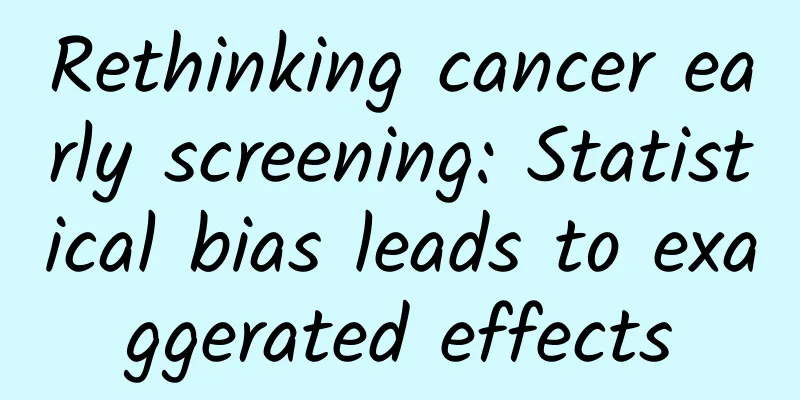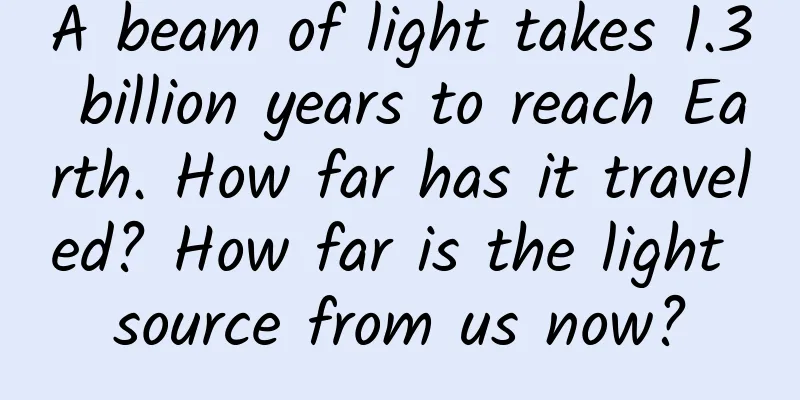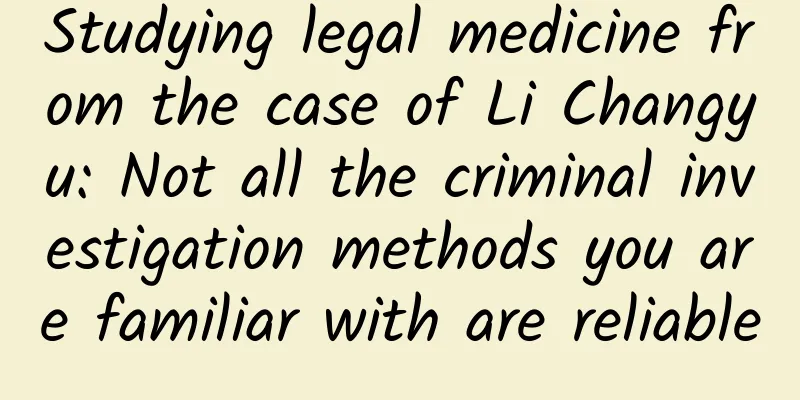Rethinking cancer early screening: Statistical bias leads to exaggerated effects

|
In the spectrum of cancer, there are not many types of cancer where "early detection and early treatment" can clearly save lives. As a whole, the benefits of early cancer screening are likely to be exaggerated. Written by | Wang Chenguang "Screening can detect early cancer and prolong life." This statement is familiar to the public and doctors. Many cancer patients and their families have heard doctors say with certainty: "Without these screening and early diagnosis methods, many cancer patients would be diagnosed with advanced disease and rarely live more than 5 years. Now it is different. Many can live more than 5 years." Outside of the professional community, few would question the universality of this assertion. However, in recent years, the value of cancer screening has been increasingly discussed in the medical community, and professionals in the field have changed their minds. Contrary to the public's half-beat perception, the current trend is to recommend reducing routine screening. This advice is counterintuitive to many people, so it becomes difficult to reverse this "common sense." Two statistical biases lead to exaggerated benefits of early screening No matter how many reasons there are to support screening, its ultimate goal is to reduce the patient's chance of dying from cancer and prolong the patient's life. It is easy to understand the logic that if humans have been helpless against a certain disease, then the only effect of early detection is to make patients and their families fall into despair earlier. This applies not only to certain cancers, but also to congenital diseases that humans have been helpless against so far. Reducing unnecessary routine cancer screening is based on the evolving scientific understanding that for most tumors, screening with the direct purpose of early detection and early treatment does not necessarily reduce cancer mortality. On the contrary, there is sufficient evidence that screening for many cancers actually does more harm than good. Statistical bias in screening results is the main reason why the benefits of screening are exaggerated. The survival time (survival period) of patients after cancer diagnosis is often used as an evaluation indicator of the value of screening. However, due to the existence of multiple data analysis biases (bias, often translated as "bias" in the professional field, for ease of understanding, the term "bias" is used uniformly below), patient survival rates cannot be used to accurately evaluate the clinical value of screening. Not only is this unclear to the public, but many medical professionals, even those who specialize in cancer, also lack a correct understanding. Screening organizations or charitable groups that care for cancer patients also intentionally or unintentionally misinterpret survival periods. Over time, if a cancer screening can increase the 5-year survival period of a diagnosed patient, it is equated with saving lives. In fact, this seemingly common-sense understanding has serious problems. What data analyses of screening results would lead to such bias in conclusions? First, let's understand the "lead time bias" in cancer screening. The time of cancer found by screening is bound to be earlier than the time of diagnosis due to the onset of symptoms (otherwise the screening will lose its meaning), and this is when the lead time bias will occur. We can set a scenario: a group of men who experience persistent coughing and weight loss are diagnosed with lung cancer at the age of 67 and die of lung cancer at the age of 70. The five-year survival rate of this group of patients is 0%. If these people were screened and diagnosed at the age of 60, but he still died at the age of 70, the life expectancy is the same, but when calculating the survival rate, his five-year survival rate is 100%. This is the lead time bias. Another situation that exists in the analysis of cancer screening data is "duration bias", which means that screening is more likely to detect cancers that grow slowly and are less invasive (called "non-progressive" cancers in the medical field). Such tumors take longer from screening diagnosis to the onset of symptoms than fast-growing tumors, which is why they are more likely to be screened. One consequence of the duration bias is overdiagnosis and overtreatment. For example, slow-growing cancers found through screening may not cause harm or require treatment during a person’s lifetime. But once they are found at an early stage, it is almost impossible for most people not to seek treatment. Imagine a scenario where a screening test for "non-progressive" cancers picks up 2,000 slow-growing, early-stage cancers. Adding these 2,000 patients to a group of 1,000 patients with "progressive" cancers, whose five-year survival rate is 40% (600 of the 1,000 died within five years), this combined statistic would artificially increase the overall five-year survival rate for cancer patients from 40% to 80% (2,400/3,000). Obviously, this increase in five-year survival is just an illusion, because the number of deaths is exactly the same (still 600). This is the result of duration bias. Large sample statistical verification whether screening can reduce mortality Because of these biases, the only reliable way to know whether a cancer screening test reduces cancer deaths is to conduct a large randomized trial to see whether there is a difference in cancer mortality between a control (usual care) group and a screening group. Unfortunately, using this analysis method, most cancer screening tests are rendered clinically useless. A study from South Korea used a questionnaire survey on 200,000 people to find out whether they had received thyroid cancer screening in the past two years. Based on the survey results, the incidence and mortality of thyroid cancer in this group from 2008 to 2010, as well as the proportion of people who reported receiving thyroid cancer screening, were analyzed, and correlations were calculated. It was found that there was a strong positive correlation between the thyroid cancer screening rate and the incidence of thyroid cancer, but there was no correlation between the incidence of thyroid cancer (whose changes reflected changes in the screening rate) and the mortality rate. The Korean study provides compelling evidence that thyroid cancer screening for the general public is more likely to be unhelpful. Studies in other countries and regions have reached similar conclusions. Another classic case comes from Japan. In Japan, neuroblastoma is a common malignant tumor with a poor prognosis in children. Studies have found that the urine of neuroblastoma patients contains excessive amounts of vanillylmandelic acid (VMA) and homovanillic acid (HVA). These two substances can be used as important markers for screening neuroblastoma, which is non-invasive and easy. In 1974, Kyoto, Japan, began a large-scale screening program aimed at detecting this tumor early by spot-checking VMA tests on infants as young as 6 months old, hoping to improve cure rates. The program was later expanded to other parts of Japan, and in 1988 the Ministry of Health, Labor and Welfare recommended the use of quantitative measurements of VMA, HVA, and creatinine to screen for neuroblastoma. In the six years from 1984 to 1989, the program screened more than 5 million infants and found 468 cases of neuroblastoma. Researchers analyzed a total of 357 cases found in Kyoto from 1974 to the end of 1988, and the results showed that the survival rate of these patients was as high as 97% (348 of 357 cases). Screening seems to increase the chances of early detection of tumors and improve patient outcomes. Subsequently, Germany and Canada also launched the screening program and evaluated the results. The German study used high-performance liquid chromatography to screen one-year-old infants, while the Canadian study used less sensitive thin-layer chromatography to screen infants aged three weeks to six months. Surprisingly, neither trial found that screening reduced the mortality rate of neuroblastoma, but instead led to the overdiagnosis of a large number of neuroblastoma cases. Because the results of these two trials were inconsistent with the results of the Japanese study, in May 2003, the Ministry of Health, Labor and Welfare of Japan organized a special committee to re-discuss the rationale of the current policy. After four meetings, the committee issued a report in August 2003. The committee believed that there was sufficient evidence that the current screening method would lead to overdiagnosis of neuroblastoma, while not finding sufficient evidence that the program reduced the mortality rate of the disease, so the report recommended not to continue screening. Subsequently, the Ministry of Health, Labor and Welfare decided to stop the program. A careful review of the evidence for the introduction and promotion of screening in Japan reveals some serious problems. Although the 97% survival rate initially obtained by the Ministry of Health, Labor and Welfare seems high, this number is typical of the "duration bias" mentioned above, that is, screening is more likely to detect cancers that grow slowly (and have a better prognosis). In contrast, tumors that grow quickly (and have a worse prognosis) are less likely to be detected by screening, but will cause infants to develop clinical symptoms sooner, such as abdominal swelling caused by the tumor. Through screening and subsequent overdiagnosis, positive infants are transformed from normal (asymptomatic) to patients, undergoing unnecessary surgery and unnecessary harm. Japan's lessons in neuroblastoma screening once again highlight the importance of rigorously evaluating the potential benefits and harms of screening programs before incorporating them into public policy. For some common types of cancer, such as cervical cancer, colorectal cancer, lung cancer and breast cancer, clinical trials have shown that screening and "early detection" can save lives (see "Some cancer screening is useless or even harmful" for a list of cancers with clear screening value). Even so, its clinical benefits are likely to be overestimated. For example, for breast X-ray screening of women aged 50 to 59, we are more concerned about what will happen once it is discovered, and ignore the fact that more than 1,300 women need to be screened to save one life. When looking at this number, we must consider the potential harms of screening, such as false positives and the fact that most nodules will never develop into breast cancer, which will cause great psychological stress and anxiety to patients and their family members, as well as unnecessary and invasive follow-up examinations; or false negative results that cause patients to ignore signs and symptoms that should have been noticed. In addition, large-scale early screening requires a lot of resources and money. When waiting for screening results, most people have a complicated mentality: they hope that their test results will be negative, but the purpose of screening is to find positive results. Due to this mentality, few people with false positives ignore the screening results, not only exhausting all kinds of confirmatory tests, but also conducting multiple follow-up tests (overdiagnosis) if they fail once. Studies have estimated that 19% of breast cancers detected by screening and 20%-50% of prostate cancers detected by screening are overdiagnosed. This situation is particularly serious in thyroid cancer screening, and some professional academic groups have even suggested revising the diagnostic criteria for thyroid cancer to deal with this phenomenon. Blind screening will inevitably lead to overtreatment Once a positive screening result is confirmed, few people can calmly judge whether treatment is needed. The most classic case in this regard is still prostate cancer. Early screening may detect slow-growing prostate cancers, which are unlikely to have a substantial impact on the patient's life span or health, and do not have clinical indications for treatment. In this case, unnecessary treatment, such as surgery or radiotherapy, will bring additional risks. The side effects of treatment include urinary incontinence, erectile dysfunction, etc. These complications will affect the patient's quality of life. Another "hard-hit area" of overtreatment caused by early screening is thyroid cancer. Similar to prostate cancer, patients who screen positive are accompanied by a series of invasive diagnostic tests (biopsy), and a considerable number of patients eventually choose surgical removal of the thyroid gland and radiation or drug treatment. I believe everyone is aware of the impact of thyroid removal on the human body. The thyroid cancers found by screening often progress slowly and rarely develop into life-threatening conditions. Even if some of them are of the type with a poor prognosis, early screening, early diagnosis, and early treatment do not mean that the patient's chance of dying from thyroid cancer can be reduced. As mentioned above, epidemiological survey data from South Korea and other regions support this view. Because of this, the mainstream medical community does not recommend including thyroid cancer screening in the physical examination program for healthy people. Not only that, due to the slow progression of thyroid cancer, the understanding of thyroid cancer by health and medical institutions has gradually changed in recent years. Some types of thyroid cancer that were previously classified as thyroid cancer have been kicked out of the cancer category because of their lower invasiveness. The removal of non-invasive follicular thyroid tumors (NIFTP) with papillary nuclear features from the cancer category is the result of this change in understanding. This change reduces the need for surgery and radioactive iodine treatment. The positive impact on patients is that it reduces unnecessary treatment and frequent monitoring, helps patients reduce economic costs and psychological burdens, and improves their quality of life. This change is also a denial of the screening program, because conventional ultrasound screening cannot clearly distinguish NIFTP from other types of thyroid cancer, and a positive screening result will lead to unnecessary invasive diagnostic tests for this group of patients. People who care about their own health need to know which cancers are preventable, which cancers can be screened, and which types of cancer screening can prolong the patient's life. Equally important, we also need to understand which screenings are meaningless and which ones are worthless even if early diagnosis can be achieved after screening. Otherwise, it is inevitable to be entangled in the information that unscrupulous testing agencies are infinitely important and even distorted and exaggerated, and in the various "luxury packages" of early screening launched by testing agencies. Once people believe these propaganda, they will fall into the maze of serial screening and even diagnosis and treatment, which will bring great harm to their physical and mental health. References [1] Ahn HS, Kim HJ, Kim KH, et al.: Thyroid Cancer Screening in South Korea Increases Detection of Papillary Cancers with No Impact on Other Subtypes or Thyroid Cancer Mortality. Thyroid 26 (11): 1535-1540, 2016. [2] Nikiforov YE, Seethala RR, Tallini G, et al. Nomenclature revision for encapsulated follicular variant of papillary thyroid carcinoma: a paradigm shift to reduce overtreatment of indolent tumors. JAMA Oncol. 2016;2(8):1023-1029. [3] https://www.cancer.gov/about-cancer/screening/research/what-screening-statistics-mean [4] Sawada T. Past and future of neuroblastoma screening in Japan. Am J Pediatr Hematol Oncol. 1992 Nov;14(4):320-6. [5] Tsubono Y, Hisamichi S. A halt to neuroblastoma screening in Japan. N Engl J Med. 2004 May 6;350(19):2010-1. The author of this article is a PhD in biology. He has served as a researcher at the Sidney Kimmel Cancer Center of Thomas Jefferson University, an associate professor in the Department of Cancer Biology, a researcher/director of the Radiation Damage Protection and Drug Research Laboratory at the Institute of Radiation Medicine, Chinese Academy of Medical Sciences, and a professor/doctoral supervisor at Peking Union Medical College. He is currently engaged in the research and development of anti-tumor drugs. This article is supported by the Science Popularization China Starry Sky Project Produced by: China Association for Science and Technology Department of Science Popularization Producer: China Science and Technology Press Co., Ltd., Beijing Zhongke Xinghe Culture Media Co., Ltd.
1. Go to the "Featured Column" at the bottom of the menu of the "Fanpu" WeChat public account to read a series of popular science articles on different topics. 2. Fanpu provides a function to search articles by month. Follow the official account and reply with the four-digit year + month, such as "1903", to get the article index for March 2019, and so on. Copyright statement: Personal forwarding is welcome. Any form of media or organization is not allowed to reprint or excerpt without authorization. For reprint authorization, please contact the backstage of the "Fanpu" WeChat public account. |
<<: Northern Lights visible in 17 states of the U.S.? Thanks to solar storms!
>>: The ultimate way to keep warm is to eat?! What foods can keep the body warmer?
Recommend
Spring is here, why has my sleep quality deteriorated?
(Image source: pexels) Written by | Ah Xian Revie...
Douyin VS Weishi competitive product analysis report!
Today is the era of short videos , which occupy a...
Is there a holiday for Children's Day this year? Is it illegal not to have a holiday on Children's Day? Attached is the latest official notification for 2022!
Tomorrow is Children's Day, and on this day ch...
9 secrets of Google Chromebooks
Generally, laptops equipped with Google's own ...
Is there any software that is fun, can be used for learning, and can also make money?
Two years ago, I was still in college and wanted ...
To Wang Xuehong: The best apology to shareholders is to sell HTC
Recently, HTC CEO Wang Xuehong bowed and apologiz...
Teacher Zhenhong's Ultimate Course: How I Make Money from Stock Trading, Make Stock Trading a Money-Making Skill
Teacher Zhenhong's Ultimate Course: How I Mak...
The advent of the era of "technological renaissance" has led to the final polarization of BAT
The Wuzhen World Internet Conference is an offici...
Electric Technology Car News: Changan CS95 vs. Trumpchi GS8: Which one is the most powerful domestically produced 7-seater SUV?
In China, 7-seat SUVs are not very popular among ...
LeEco Mobile Phones "Compete on Costs" to Clear the Mist and Move Towards Free Hardware
In 2015, LeTV once again emerged as a dark horse ...
Why does Xiaomi want to engage in Internet finance during the bull market?
Today, Xiaomi Finance officially launched its Int...
The next stage of self-driving cars: You can take a nap in the car
According to foreign media reports, the problem w...
Baidu Maps helps you predict the future, so you don’t have to fight the traffic during the May Day holiday
The May Day holiday is halfway through. Are you s...
NetEase's Turmoil and Ding Lei's Calculations
On Friday night, the news that Yang Binbin, deput...
Uncle Chen's "Landing and Monetization Course for Knowledge Anchors" video
Uncle Chen's "Landing and Monetization C...









